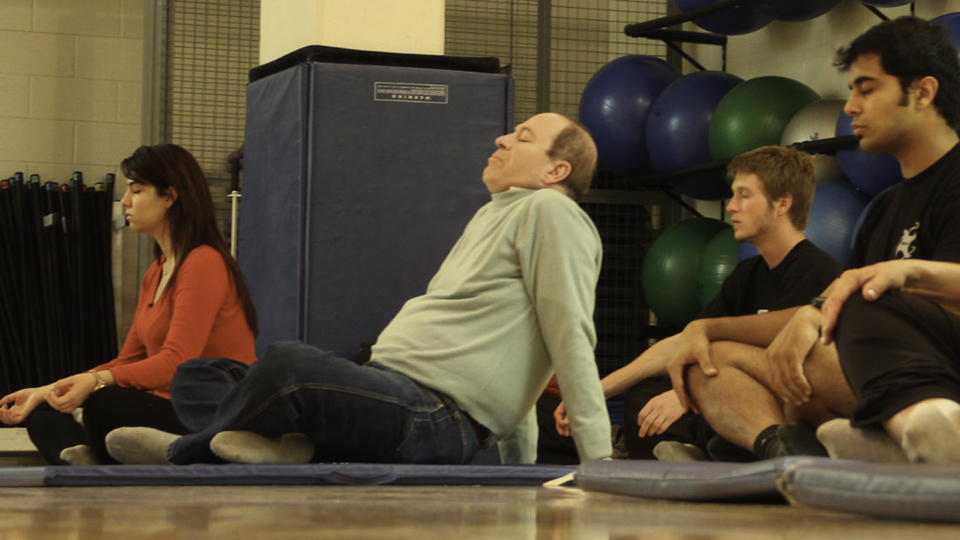Zindel Segal, a psychiatry professor at U of T, describes mindfulness meditation as a way to reclaim a choice we forget we have: which thoughts will we pay attention to, and which do we choose to ignore? Through “mindfulness”—or the full awareness of our thoughts and sensations—he says we can shut unwanted emotions out and keep positive feelings in. In other words, we gain control.
As the founder of mindfulness-based cognitive therapy, Segal joins a Buddhist tradition that dates back to the fifth-century BC prince Siddhartha Gautama. “We are shaped by our thoughts,” Gautama philosophizes in the Dhammapada, an ancient collection of his sayings. “We become what we think.”
Jump 2,500 years later, and neurological research across North America suggests that meditation alters the structure of your brain and how your DNA chooses to express itself. Segal’s own lab results show that meditation had an effect comparable to antidepressant pills. These studies give fresh meaning to the cliché “mind over matter”. Can we control our thoughts—and through them, our bodies?
In the dimly lit dance studio of the RAWC, Jeffrey Saah, a mindfulness meditation guide in a student-run initiative at UTM, begins the meditation with a series of muscle stretches. With our bodies relaxed, we sit cross-legged on mats as Saah asks us to close our eyes and “visualize”. Out of the darkness we create a forest, a pond, a golden temple, and a mountain. Saah instructs us to pay attention to every sensation in the blades of grass, cool water, and fresh air. For nearly an hour, we explore this world.
“Now, in five seconds,” Saah continues, “you will imagine that this entire world you have created—the trees, temple, and mountains—will get sucked back inside your heart. After that, you will open your eyes.”
He begins to count: “Five… four… three… two…”
One. When I open my eyes, I start to miss my meditative self as reality settles in. But Shouvik Biswas, another meditation guide in the group, says that we carry the potential to unlock that peacefulness if we choose to do so. “As a guide, I am simply showing you what is pre-existent inside of you,” he explains. “I am merely guiding you in finding the centre.” Biswas echoes Segal’s notion that through mindfulness, we can reclaim an innate control over ourselves. But how do you define this control, and where does it come from?
In 2009, a group of scientists at the Harvard Medical School studied the genes of people who meditated for eight weeks. The group included Herbert Benson, one of the first Western doctors to bring meditation into medicine. Through blood samples and DNA analysis, Benson and his team found that their participants’ gene expression had changed since their first meditation session. Meditation apparently had activated the genes that prevent stress and deactivated the genes that provoke it. This finding lines up with the increased sense of relaxation the participants felt after meditating.
Such changes in gene expression are called “epigenetic”, from epi-, the Greek for “above” or “over” the genes. Does meditation allow us to make epigenetic changes?
If epigenetics deals with changes to gene expression at the molecular level, the phenomenon of neuroplasticity has a similar effect on brain cells. It’s essentially the ability of your brain to change and adapt. In recent years, scientists have increasingly linked meditation with neuroplasticity. In 2011, Dr. Sara Lazar and her team at the Massachusetts General Hospital found that people who practiced meditation for a long time showed increased brain density in the areas that regulate emotions and perception. At the University of California, David Creswell’s lab showed that during meditation, the prefrontal cortex was activated, apparently to quiet down another part of the brain—the amygdala. The amygdala is the brain’s emotional centre; a quiet amygdala means calmness.
If Lazar’s and Creswell’s findings apply outside of the lab, they could prove that meditation allows us to regulate our thoughts and emotions through biological means. Since the fields of epigenetics and neuroplasticity are still young, findings in them are still open to debate.
Meanwhile, Segal hopes that the recent attention on mindfulness meditation will not position it as a “quick fix”.
“People can go, ‘All I need to do is be mindful,’ and then perhaps they try meditation and discover it’s not easy,” Segal said in a Globe and Mail article. Instead, he is pushing for the image of mindfulness meditation as a sort of training. Likewise, Biswas, who is also a UTM student and has practiced meditation for about eight months, describes his own mindfulness experience as a “work in progress that gets easier every day”.
Biswas, Saah, Vanessa Sabucco, and the meditation group’s events coordinator, Karin Sidey, are a team of students that lead mindfulness meditation sessions with the simple goal of helping people “de-stress”. And while the biological mechanisms behind meditation remain speculative, the fact that sessions draw students and athletes in every week speaks to their own effectiveness.
Can we reclaim control over our thoughts? In his mindfulness meditation sessions, Saah puts it as a very real choice. “As you visualize,” he says, “remember: you feel strong. You feel capable. You can do anything.”




I took this class!! We had Vanessa Sabucco and it was so great! It was during my undergrad when I was so stressed and she not only taught us how to meditate (which I still practise to this day!) but she taught us ‘mindful yoga’ which was my first and best experience with yoga. Vanessa Sabucco, do you still teach yoga?!